Some of the best beer tourism happens in places that are already centres for “ordinary” tourism, with plenty of stuff to see that is nothing to do with beer. That’s what makes Brussels a great place to be a beer tourist. There are many attractions apart from breweries and bars .You can wander about checking out the marvellous architecture, the shops, the parks, the churches, the waffle shops, the chocolateries, the stores, spot all the references to René Magritte, visit a wider variety of museums that you’ll find in most cities – the Magritte museum, the chocolate museum, the comics museum, even the beer museum, though to be honest that last one, in the basement of the brewers’ guild building in a corner of the Grand Place, is rather a disappointment: for €5 you get a short film about brewing, a chance to see a few bits of old brewing kit, some mugs and some old pictures, and a complimentary beer at the end.
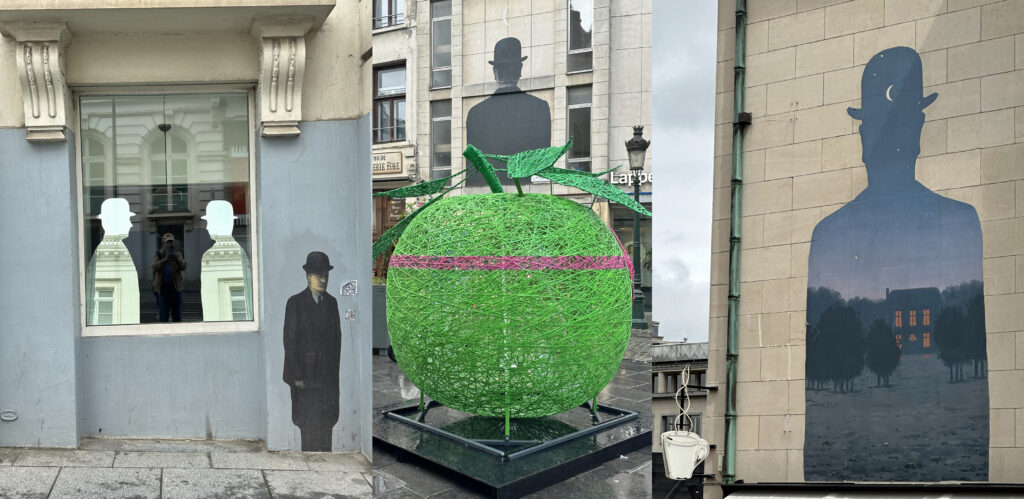
Rather than the beer museum, check out somewhere like the Brussels Beer Project, started on the “trendy” Dansaert Street in central Brussels in 2013 by Sébastien Morvan, from France, and Olivier de Brauwere, from Belgium (nominative determinism in action there: “Brauwere” means “brewer”) to, in their own words, “Wake Belgian beer up, dust it and get it out of the Middle Ages”.
According to BBP, “ten years ago nobody in Brussels had ever heard of an IPA.” The whole project has been crowd-funded with an offer of “beer for life” – for 200 euros you got 12 beers a year – which had attracted 2,000 subscribers in its first two years. The first beers the pair made were brewed for them by Brouwerij Anders! (sic), a contract brewery founded only in 2011 in Halen, some 30 miles east of Brussels. Morvan and De Brauwere got drinkers to vote for their favourite out of four initial beers, Alpha, Beta, Gamma and Delta, and the winner was Delta, a “saison IPA”.
Older drinkers were sceptical, but young Bruxellaires were very happy to have these new types of beer available in their city: BBP’s brew number two, for example, was a hefeweize crossed with a tripel. In their third year the pair opened a pilot brewery at their café in Dansaertstraat, though they still kept brewing at Anders!. A stream of experimental beers came out of the vats in Dansaertstraat, at a rate of one a week, including one with cigars infused in the brew, and another where speakers had been dropped into the fermenting vat.
Morvan and De Brauwere opened another, larger brewery on the outskirts of Brussels in 2021, and converted the Dansaertstraat brewery into a lambic operation: since they were based in the Senne valley, the only place legally (or so some claim) that lambic can be brewed, doubtless the chance to add some ancient to the modern was impossible to ignore. They installed a small steel coolship in the Dansaertstraat premises, plus 200-litre foeders to mature the lambic in, and once the night-time temperatures fell below 5ºC they threw open the windows and let the Senne valley bugs and microbeasts waft in and fall into their freshly brewed and slowly cooling wort. Purists complained that they did not have the traditional wooden beams above their coolship, which in older lambic breweries is supposed to be a place where the yeasts and bacteria that make lambic what it is congregate. Morvan and De Brauwere replied by “deconstructing” an old wooden cask and erecting it over their new coolship, to give the Brettanomyces, pediococcus and so on a hopefully permanent home.
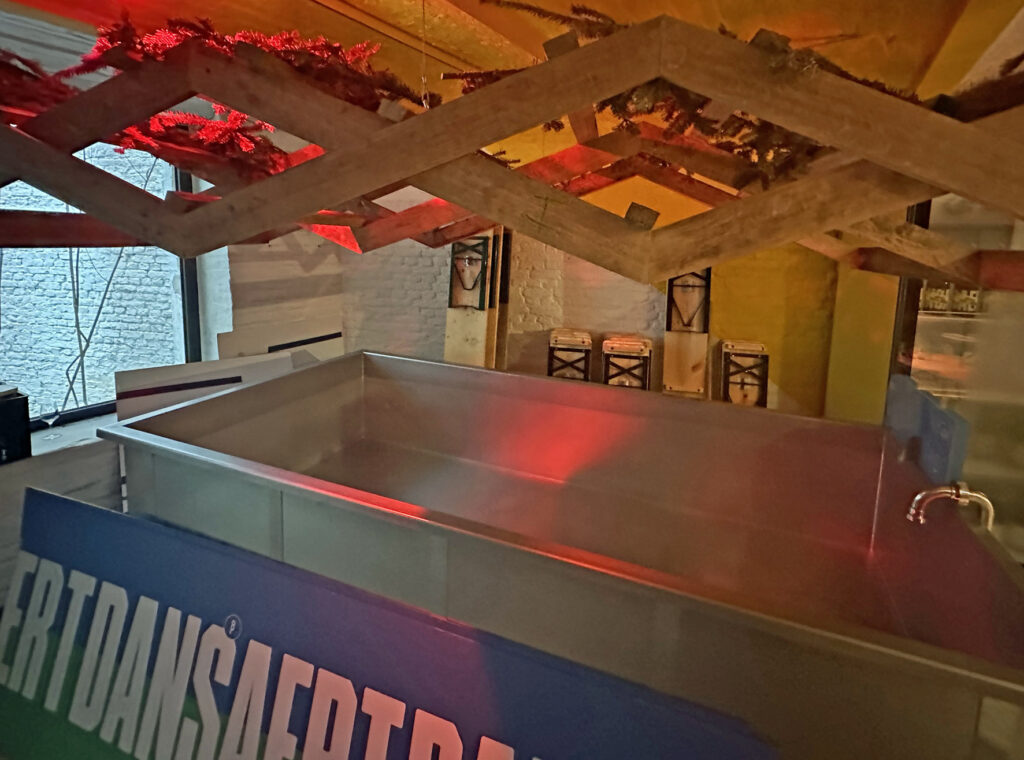
The BBP lambic brewery makes a fascinating contrast to Brussels’s one remaining “traditional” lambic operation, Cantillon, less than a mile to the south. One of the beers that BBP is producing is a blend of 60 per cent Delta saison IPA and 40 per cent one-year-old lambic, funky on the nose, slightly sour and tart, a delightful reminder that new experiences can still be created from old traditions.
After BBP we walked the mile north to Brasserie de la Senne, to sit and drink in the brewery’s Zenne Bar alongside its new production site, built in 2020, and designed to make the production processes inside as visible to the public as possible, with a 30-feet-high glass wall facing the street. I was very much more happy with the brewery’s Brett Porter than I had been with the handpumped Taras Boulba the day before: subtly bretty, nicely dry, quite light but at the same time middlingly complex, with aromas of chocolate and roast grain.
If Friday was a comparatively quiet day walking round Brussels, Saturday was busy busy: an early start to catch the train out to Lembeek, and then more walking out to the Boon brewery, for a look round one of the best known producers of gueuze and lambic. I had actually been there last autumn, on one of Paul Davies’s AleHunter tours, but I was very happy to go back: there’s something about halls filled with giant foeders filled with beer upon which wild organisms are working slow magic that excites and delights me.
A tour of the brewery and its cellars ended up in the Boon Bar, where Frank Boon himself was pouring beers. I was simultaneously flattered and alarmed when Frank spotted me and asked if I was Martyn Cornell, who had written a review of Raf Meerts’s highly controversial book on the history of lambic, published last year, which basically attempts to trash everything Frank and most of the other lambic producers say about the origins of the beer style, and push Brussels in the late 18th century, not the Pajottenland in the Middle Ages, as the time and place when lambic came into being. I admitted I was, and was deeply relieved to find that Frank seemed to think my review had been fair and balanced: I spent some time attempting to persuade him to write his own history of the beer: sadly, he declared himself far too busy promoting and defending traditional lambic brewing through organisations such as HORAL, the lambic brewers’ association, to have time to put fingers to keyboard.
We left the Boon brewery, reluctantly, for a two or three-mile walk through the bosky Flanders countryside to the tiny settlement of Kluis, for lunch at the Café de Kluis, the Flemish equivalent of an English country pub – except serving a fine range of lambics, of course. The quiet dappled shade of the café’s garden is a perfect place to enjoy a beer and a plate of Belgian pasta – or it would be if lunch wasn’t accompanied by intermittent Belgian rain, which dappled shade doesn’t protect against. Fortunately there was room inside, just, for all 18 of us. The other customers included, just as it would in an English country pub, the obligatory old boy with white beard and flat cap standing at the bar chatting to the landlady, and I smiled at him, before realising that, despite the fact that I don’t feel much more than 17 inside, he was probably younger than me – even Frank Boon is younger than me, ffs.
The Café de Kluis is soaked to its brickwork (which knights of the trowel and mortarboard will notice from the photograph is constructed, curiously, in English bond – alternative courses of headers and stretchers – rather than Flemish bond, header followed by stretcher in each course) with what the Dutch call gezelligheid, which doesn’t have a good translation in English, but which covers “cosiness”, “sociability” and “relaxation”. It’s a place anyone will feel instantly at home in, helped by a fine selection of lambic and gueuze on draught and in bottle, and the usual simple but spot-hitting Belgian pub food menu.
Despite being laden with Belgian spaghetti Bolognaise (there’s an essay to be written on the difference between British spag bol and its Belgian cousin – Pete Brown?), we managed the 20-minute walk to Halle station to travel the short distance to Lot, and the Drie Fonteinen lambik-O-droom, the long, open tasting room next door to the giant foeder facility for one of my personal favourite lambic breweries, a favourite in part because of the amazing tenacity of founder Armand Debelder and his family in keeping the concern in operation, and dedicated to producing the best, most locally focused beer that they can.
The beer menu at the lambik-O-droom has one of the widest lists, in age and variety, you will encounter, probably, from any single brewery, though (sob) the handpumped faro had run out just before we arrived. Still, this is where going in a large group really pays off: nobody, on their own, is going to be able to afford – or get through – several different 75cl bottles of ancient gueuze at €70 a time. Hurrah for my fellow travellers’ willingness to share their purchases – thank you so much, guys and guyesses, especially John Allison – which meant I was able to try a range of different beers in what was one of the highlights of the tour. Some are now astonishingly rare: the Armand’4 Herfst (autumn), for example, part of the Four Seasons series, released in 2010 to raise funds for a new brewery after the infamous “thermostat incident” of 2008 ruined almost all the brewery’s stocks. The Herfst blend of three different lambics includes some of the last of the brewery’s beer that survived the thermostat failure, which saw more than 80,000 bottles of lambic ruined. Today it is a hugely contemplative drink, with deep bass notes rumbling away, cigars, mushrooms, even – in a good way – musty old books. Give me a log fire, a leather armchair and a bottle of this and let autumn throw its worst at the window. (Some of those beers are also now dangerously explosive: the cork on one gueuze John ordered sailed over his head – and he’s six foot 11 – as the bar person opened it.)
The Winter, from the same series, and just as rare and expensive, was dialled back compared to the Herfst, but still with plenty of fascinating funk: cheesy feet, in this case, which may sound horrible if you’re not used to aged Brett beers, but was actually excellent.
Other beers we tried included a lambic with elderflower, which didn’t work for me – I like elderflowers, they sit nicely in the gooseberry/sauvignon blanc Venn circle, but the floral notes here clashed badly, I thought, with the sour funkiness. Kweepeer – the Dutch for quince – on the other hand was more successful, made with macerated organic Flemish quinces soaked in young lambic for four months and blended with more young lambic before bottling: no quince on the nose, but definite quince notes in the aftertaste.
Drie Fonteinen also does a range of lambics aged in different woods, including oak, acacia, chestnut, ash, cherry and mulberry. The range is called “Spelingen van het Lot”, “which as a phrase means “twists of fate”, but is also a nice play on Lot as the name of the place where Drie Fonteinen ages its beer. I tried the chestnut-aged blend, which was laid-back, with a ruddy sweetness coming through the sour.
Reluctantly, again, we dragged ourselves away and back to Brussels. There I had decided upon a visit to Nüetnigenough, a tiny and comparatively new restaurant close to the Grand Place which describes itself as “The Brussels brasserie for greedy gluttons and fine beer lovers” – a description which fits me to a tight T-shirt. Nüetnigenough doesn’t take reservations – turn up and queue outside. Now, normally, being a solo diner is a real disadvantage: restaurateurs don’t generally want you, you’re taking up a table that could be occupied by two or more diners, thus knocking their yield. Nüetnigenough, however, is SO tiny it only has 18 or so covers, one of which is actually a table for one, since there would otherwise be no room for the waiters to get past. So there I was about sixth back in the queue, a waiter came down the line checking on the size of each party, and when he got to me and I said: “Un!”, I was ushered straight in, past some pretty angry-looking people …
It’s a traditional menu, and the portions are enormous: I noticed the man at the table next door had the shoulder of pork, which easily broke one of my golden rules of gastronomy – never eat anything bigger than your head – and I thought: “Mate, there is no way you are going to finish that.” Predictably, I saw him leave at the end with easily half that shoulder in a plastic food container … I went for the Carbonnades Flamandes – well, you have to when in Belgium, at least once, especially when it’s made with St Bernardus Prior – accompanied by, among others from the restaurant’s extensive beer menu (27 or so breweries, more than 130 beers), Charbon, from the Dochter van de Korenaar brewery in Antwerp the little Belgian enclave of Baarle-Hertog, a couple of miles inside the Netherlands, a dry stout made with oak-smoked wheat malt and vanilla, which, as I had suspected, matched extremely well with the stew (itself excellent, the meat meltingly moist, the gravy rich as Croesus).
Next day, Sunday, suitably, was Southern Monasteries Day, and an early start in order to arrive 50 miles away at the Abbay de Scourmont in time for a Chimay breakfast – four different Chimay beers, all in the classic chalices, on a neat wooden stand, with Chimay cheeses plus meats and pickles. Breakfast of champions indeed … if it wasn’t for the highly likely liver and weight issues, I could do THAT every day of the year.
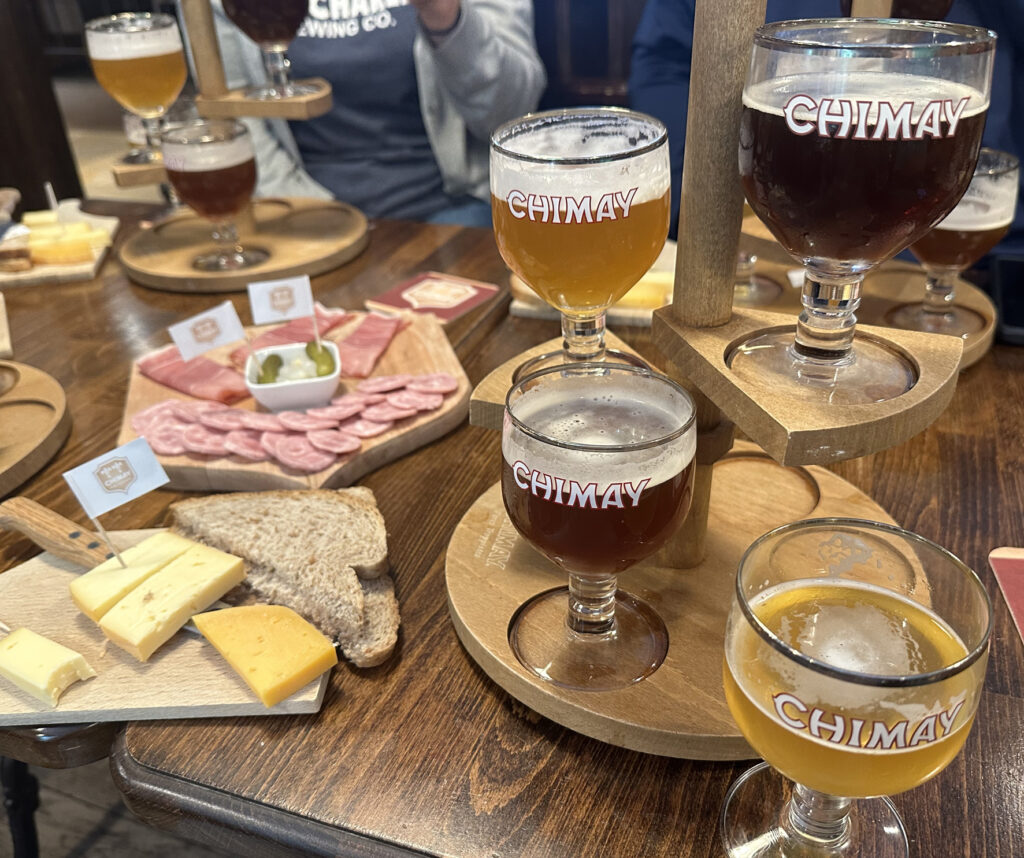
No rest for the wicked beer drinker, however, we have another 55 miles to travel, to reach the Abbaye d’Orval. This is another stop that goes far beyond mere beer tourism: the abbey is a beautiful place in a beautiful slice of country, the Ardennes, all hills and forests, and it’s a real pleasure to wander the grounds, taking in the ruins of the medieval abbey, the Mathilde fountain, where legend says the Countess of Tuscany lost her wedding ring more than 900 years ago, only to have it returned to her by a trout, and the modern buildings of the second foundation, built between 1926 and 1948. And while you (generally) cannot visit the brewery that makes the beer the abbey is famous for, there is a well-designed and informative brewery museum, with plenty of shiny kit to admire. After that you can walk down the road to the Ange Gardien restaurant and try out different ages of Orval against each other: November 2021 versus June 2023, for example.
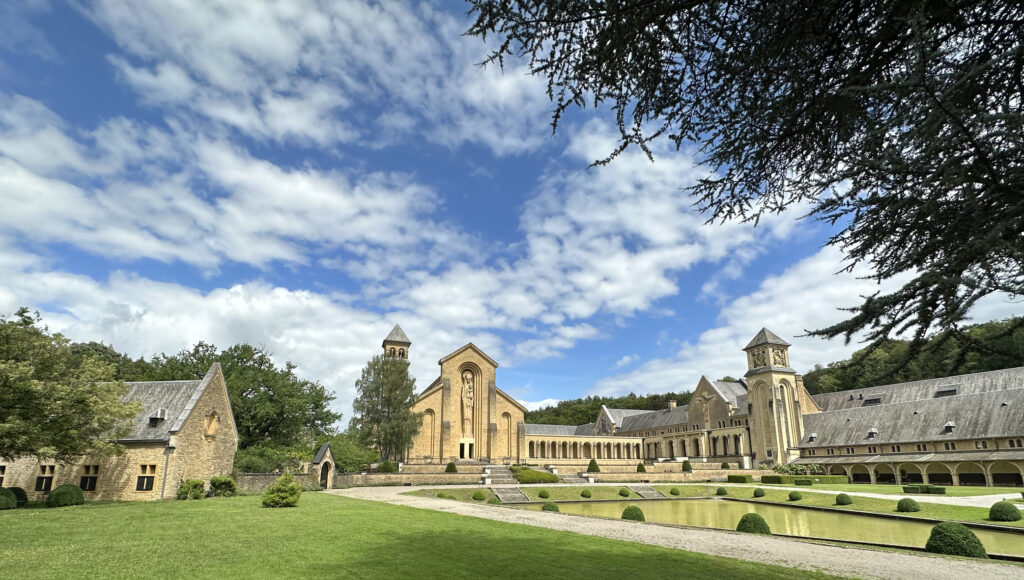
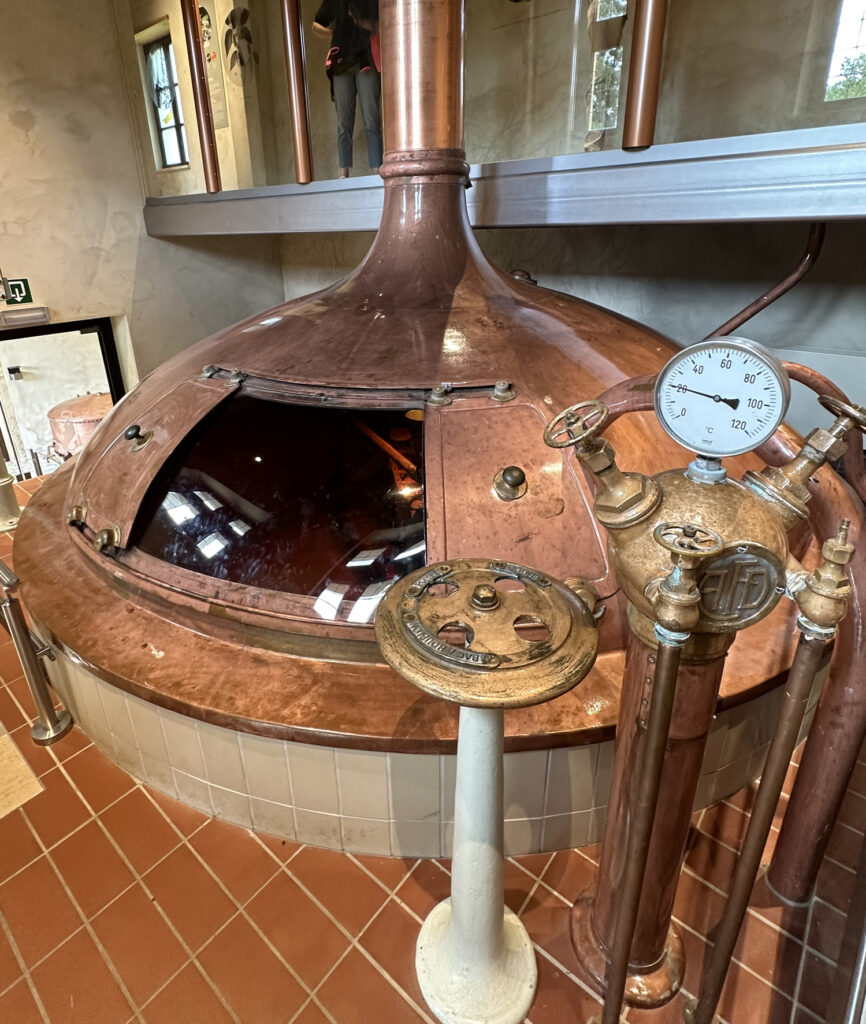
We still had to get back to Brussels for our last night in the city, however, which we did via Rochefort, the third in the trio of southern Belgian brewing abbeys: no chance of a visit, just a genuflect outside the gates. Finally, after our 200-mile loop through Wallonia, we were back at our hotel. Strangely, I still felt hungry: fortunately Brussels bars stay open late even on a Sunday, so even at 10:30pm I was still able to get a huge bowl of mussels, a basket of frites and a glass of Kwak, another of those I-don’t-care-if-it’s-a-cliché-I-still-like-it Belgian beers. Having explained to John Allison, my companion in mussel eating, what is supposed to happen when you order Kwak in a Belgian bar, I managed to make the waitress laugh by offering her my shoe as hostage for the famous Kwak glass: is that still a thing?
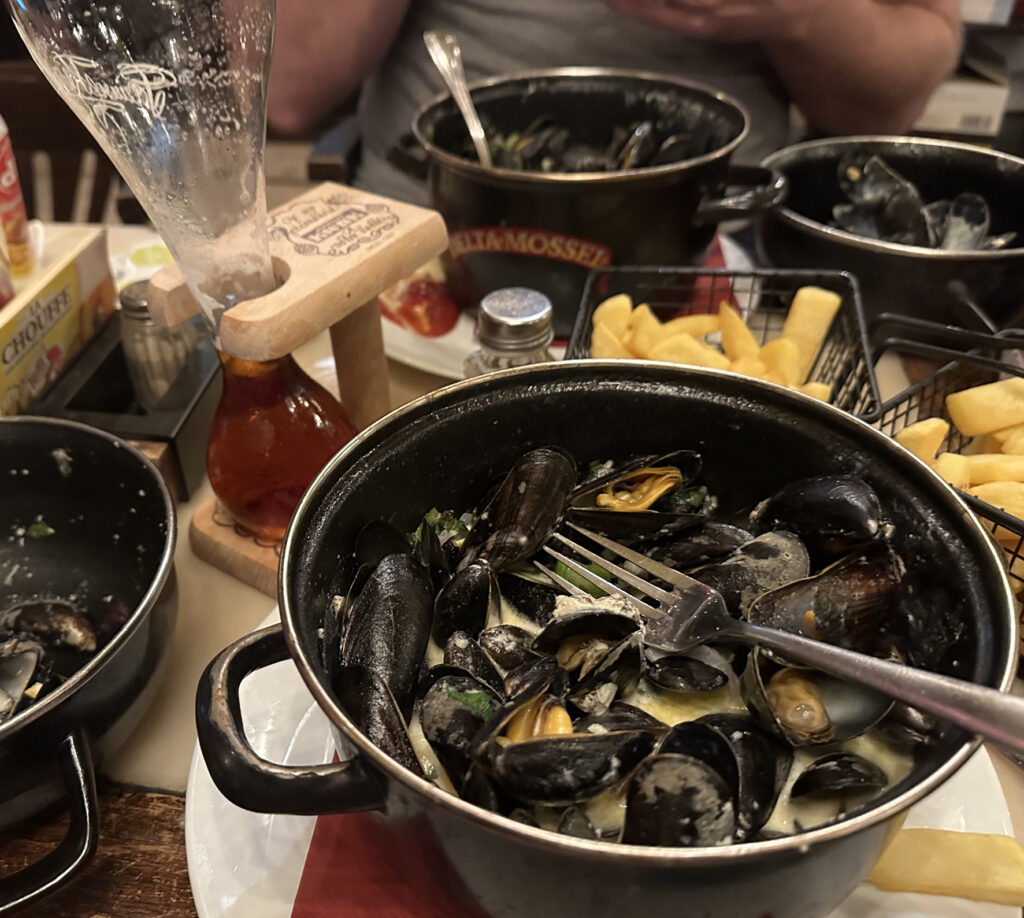

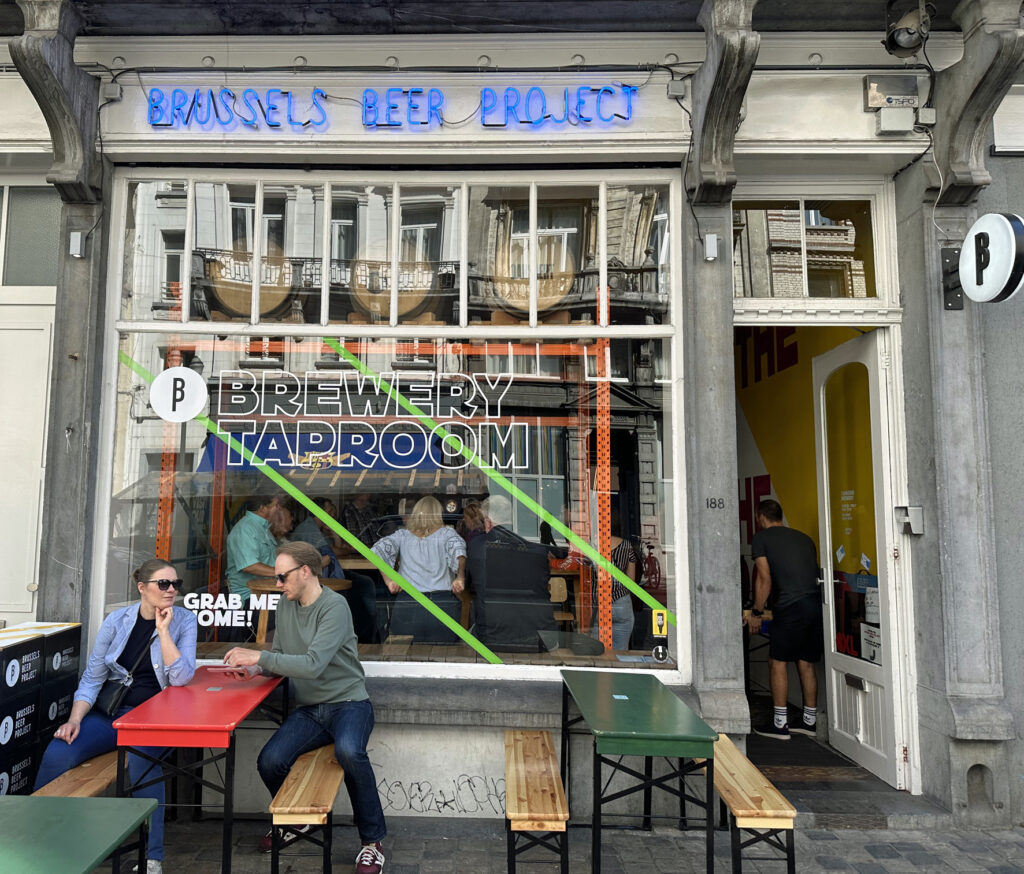
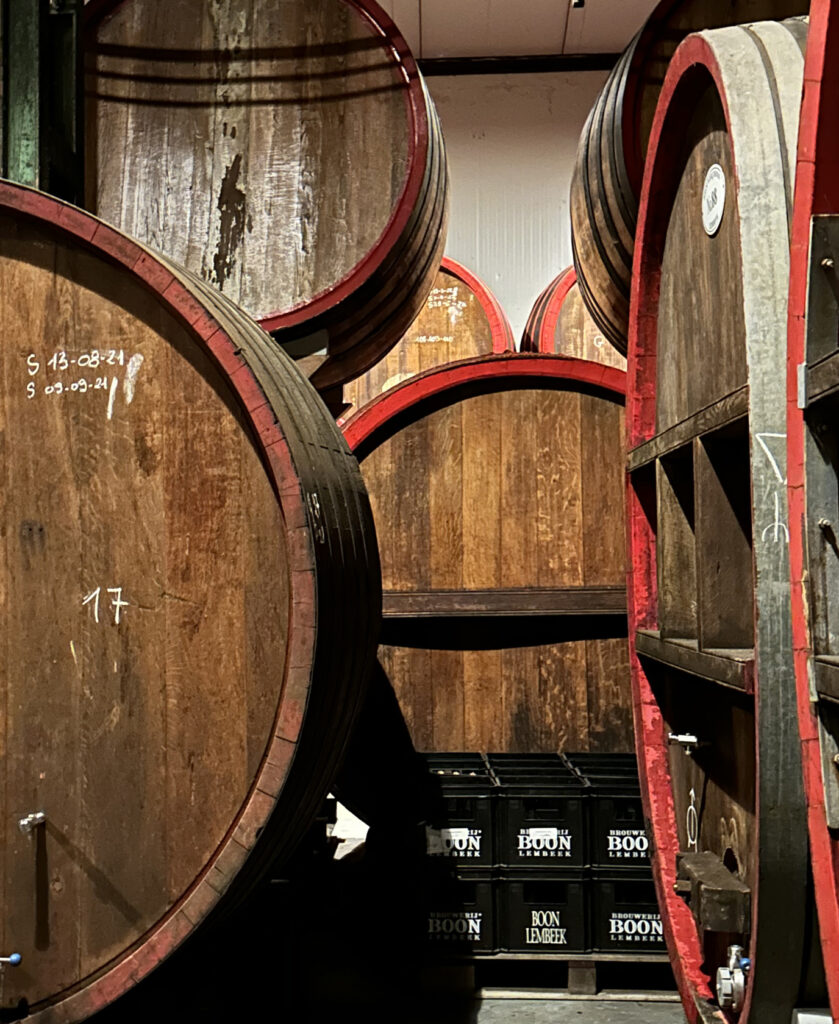
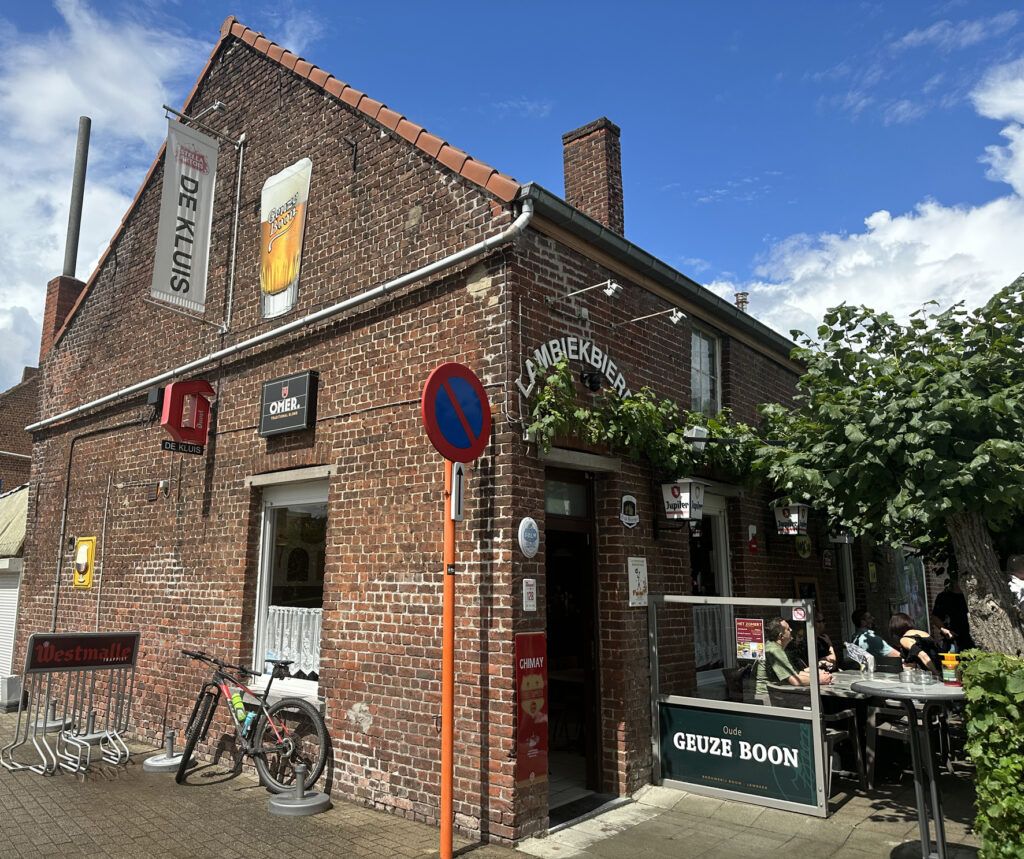
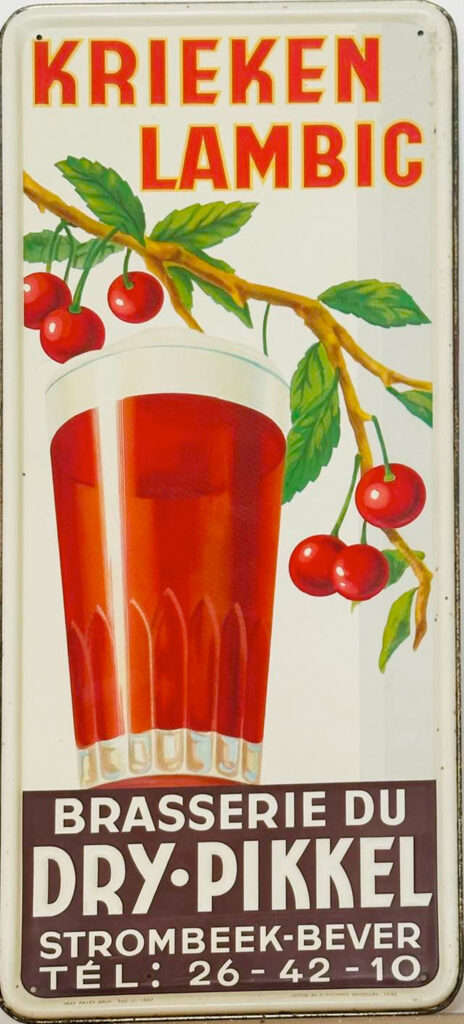
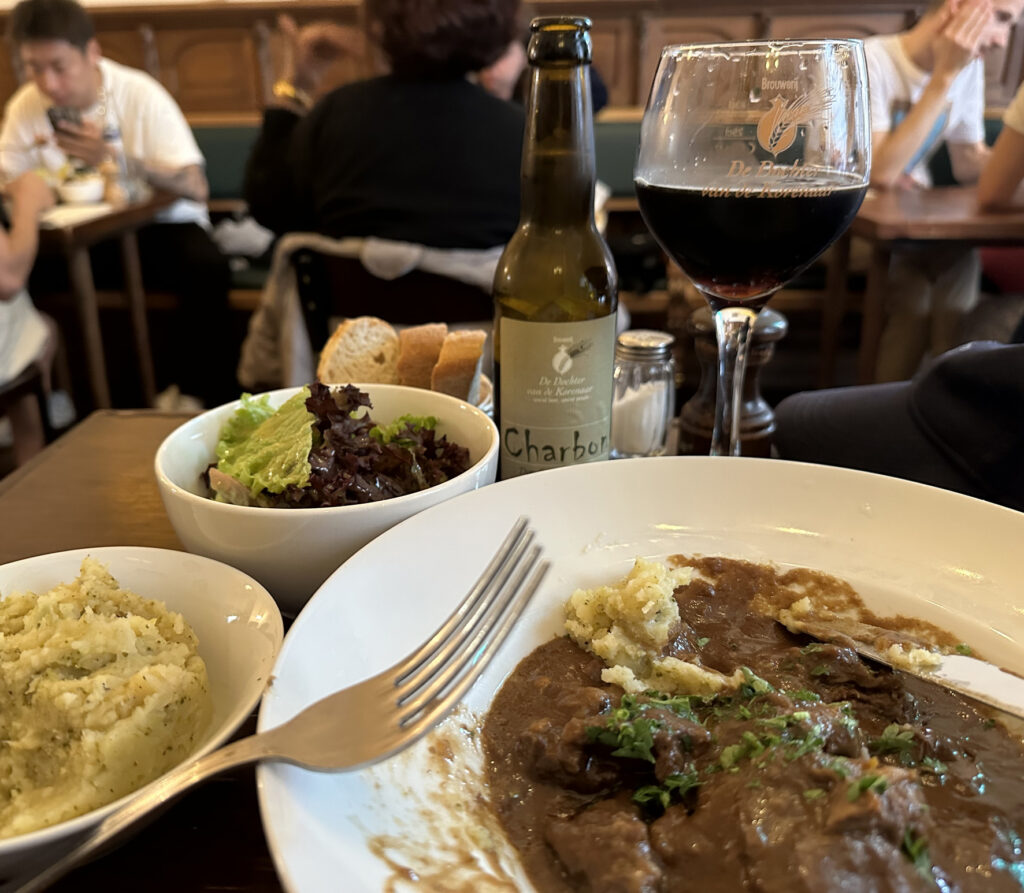

[…] To be continued […]
A splendid read – as always. One minor detail: Dochter van der Korenaar is not located in Antwerp, but in a tiny Belgian enclave in The Netherlands.
That’s right – it’s located in Baarle-Hertog, which is a separate municipality located within the *province* of Antwerp,
Thank you for that, now corrected …
Hi Martyn,
Just a small note, “based in the Senne valley, the only place legally that lambic can be brewed” is not true. That is a myth.
Raf Meert’s book discusses this, though I can’t tell off the top of my head which chapter.
“Wake Belgian beer up, dust it and get it out of the Middle Ages”.
Sorry, Martyn, but I’m with the sceptical older drinkers (being a sceptical older drinker myself). When someone says that you know what they mean – “we’re pretty much going to brew American-style craft beer, there or thereabouts.” Which in my humble opinion is not really what the country with the broadest range of beers in the world actually needs.
But that’s very much my opinion – each to their own, of course.
“speakers had been dropped into the fermenting vat”
Loud or public?
Looking to sign up to your blog and could not figure out how to do that, so sending you an email. Enjoying your blogs on the trip. Hope you are doing well.
A great read (both parts). I don’t personally choose the US leaning craft styles of BBP or De La Senne when in Brussels, but I appreciate the residents deserve to have a choice of something different regardless of my own predilections.
[…] umbrella heading “If it’s Tuesday, this must be Kölsch!” So far we have parts one, two and three with more promised. It’s a bit mind melting in the pace, one which may tax even […]